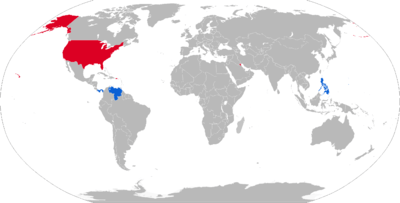LAV-300
| LAV-300 | |
|---|---|
 A Cadillac Gage LAV-300 (Light Armored Vehicle) of the Philippine Marine Corps | |
| Type | Light Armored Vehicle |
| Place of origin | United States |
| Service history | |
| In service | 1979 – present |
| Used by | See Operators |
| Wars | |
| Production history | |
| Manufacturer | Cadillac Gage |
| Unit cost | $USD562,900 (2003)[1] |
| Produced | 1983-1994 |
| No. built | 103[1] |
| Variants | See Variants |
| Specifications | |
| Weight | 14,696 kg. |
| Length | 6.40 m |
| Width | 2.54 m |
| Height | 2.7 m (turret roof), 1.98 m (hull top) |
| Crew | 3+9 |
|
| |
| Armor | classified |
Main armament | 1 x 90 mm, 1 x 7.62 mm Machinegun |
Secondary armament | 2x6 40 mm Smoke Dischargers |
| Engine |
Cummins 6 CTA 8.3 diesel turbo charged engine 260 bhp |
| Power/weight | 18.36 bhp/ton |
Operational range | 925 km |
| Speed | 105 km/h (road), 3 km/h (water) |
The Cadillac Gage Textron LAV-300, originally named as the V-300,[2] is a family of American light armored vehicles (LAVs) including up to 15 configurations. It was originally created and designed by CG as a private venture project.
LAV-300 offers high mobility, speeds of up to 65 mph (105 km/h), and can be air-transported by a C-5 Galaxy, C-141 Starlifter, C-17 Globemaster III and a C-130 Hercules cargo aircraft.[3] Some versions can be air-transported by CH-53E Super Stallion helicopter.[3]
History
The first country to buy it was Panama, which purchased 12 LAV-300s in four configurations.[2] Most of them were captured by American forces during Operation Just Cause.[2] Kuwait placed an order in 1984 for 62 vehicles, some of them in Fire Support Vehicle configuration.[4] Most of Kuwait's LAV-300s were destroyed by Iraqi troops during the 1990 Invasion of Kuwait.[5]
The Philippines placed an order in 1993 for 24 LAV-300 MK IIs, 12 in APC configuration and 12 in FSV configuration, which were delivered by 1995.[2] The contract was worth $USD18.243 million.[1]
Production of the LAV-300 ended in 1994 with marketing discontinued by 2000.[4]
In 2017, during the Battle of Marawi the Philippine Marine Corps along with the Army used wooden planks and stacked cardboard as improvised vehicle armour for their LAV-300 FSV's along with Commando V-150's, M113A2 and Simbas against ISIS-inspired militant groups like the Maute-Abu Sayyaf.[6][7][8] Though not as effective as proper armor, these field modifications allowed better resistance against 40 mm grenades and Improvised explosive devices that were common in the rebel arsenals.
Design
Armor
The LAV-300's armor is composed of a high-hardness steel armor employed on a minimum silhouette hull capable of withstanding impacts of 7.62 mm caliber bullets at point-blank range and from any angle. Upgradeable armor floor plating protects the crew from landmines and hand grenade blasts. The survivability is further enhanced from low observable technology to minimize levels of thermal, seismic and audio signatures, and minimal radar return.
Maneuverability
Highly mobile, the LAV-300 MK II is fully amphibious with no need for preparation for fording or swimming. The tires are radial tubeless and can be outfitted with run-flat inserts and a central tire inflation system, to further enhance mobility. LAV-300 MK II can climb a 60 percent gradient, operate on a 30 percent side slope, and tackle two-foot-high obstacles.
Engine
LAV-300 MK II’s turbocharged diesel engine allows for acceleration from 0 to 20 miles per hour (32 km/h) in less than 10 seconds and can run on Jet-A fuel, kerosene and other lighter fuels when diesel is in short supply. The six-wheel, dual hydraulic brakes permit the vehicle to go from 20 miles per hour (32 km/h) to 0 in approximately 40 feet (12 m). LAV-300 MK II’s operating range is 575 miles (925 km).
Variants
The LAV-300 has fifteen different configurations—the most common being: command, armored personnel carrier, anti-tank, military logistics, ambulance and armored recovery vehicle.[2]
The following turrets are available for the LAV-300:[2]
- 7.62 mm machine gun combined with 12.7 mm, 25 mm, 30 mm or 40 mm guns
- 20 mm anti-aircraft gun
- BGM-71 TOW anti-tank guided missile
- 90 mm gun
- 81 mm and 120 mm mortars.
LAV-300 MK II
An improved version of the LAV-300, known as the LAV-300 MK II was developed in the 1980s with an aftercool type engine, improved transmission with 6 forward and 2 gear ratio with better tires and a larger fuel tank.[2]
Operators

Current operators

Former operators
References
- 1 2 3 "V-300/V-600 Commando - Archived 8/2004". Forecastinternational.com. Retrieved 2017-07-30.
- 1 2 3 4 5 6 7 Pike, John. "LAV-300/LAV-600". Globalsecurity.org. Retrieved 30 July 2017.
- 1 2 "LAV-300". Deagel.com. Retrieved 30 July 2017.
- 1 2 "Vehicles in Focus: LAV-300". Armored Warfare - Official Website. Retrieved 30 July 2017.
- ↑ Laur, Colonel Timothy (1995). Encyclopedia of Modern US Military Weapons. Berkley: Berkley Publishing Corporation. ISBN 978-0425147818.
- ↑ "Images surface of wood armor on Philippine military vehicles fighting ISIS: Could that actually work against an RPG? - SOFREP". 9 June 2017.
- ↑ "IN PHOTOS: Military opens Mapandi bridge to media amid heavy fighting in Marawi".
- ↑ "These ISIS-Fighting Philippine Tanks Are Clad in DIY Wooden "Armor"". 7 June 2017.
- 1 2 3 "LAV-300 Cadillac Gage Textron Light armoured vehicle". Army Recognition. Retrieved 17 March 2016.
- ↑ "Armor Update". pmcmssr.tripod.com.
- ↑ ngain. "Philippine Marine Corps to upgrade turrets of its armored fighting vehicles - February 2015 Global Defense Security news UK - Defense Security global news industry army 2015 - Archive News year". www.armyrecognition.com.
- ↑ "Former Equipment of Iraqi Army". Archive.org. Retrieved 17 July 2018.
| Wikimedia Commons has media related to LAV-300. |